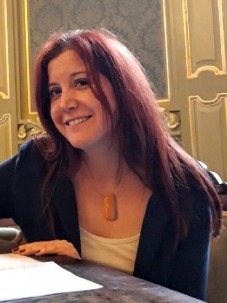Identifying ancient scribes using Artificial Intelligence

PhD student Gemma Hayes has researched the output of a scribe identified by artificial intelligence (AI). On 9 February 2023, Hayes will defend her dissertation Searching for Dead Sea Scribes: A study on using artificial intelligence and palaeography for writer identification in correlation with spelling and scribal practices, codicology, handwriting quality, and literary classification systems for Dead Sea Scrolls.
Hayes’ research is embedded within the broader interdisciplinary project ‘The Hands that Wrote the Bible: Digital Palaeography and Scribal Culture of the Ancient World’, funded by the European Research Council (ERC). By combining traditional and digital palaeography methods with radiocarbon dating, this project has generated new ideas on writer identification and the typological developments of writing styles in the Dead Sea Scrolls.
From Down Under to northern shores
Hayes’ interest in palaeography, the study of the development of handwriting over time, was piqued during her Bachelor’s studies in Melbourne, Australia. While she was studying the Ancient Judaean world, she completed an assignment on the Dead Sea Scrolls. Her interest led her to obtain a Master of Letters in Jewish and Christian Studies at the University of Sydney. Her PhD dissertation builds on her previous work by focusing on palaeographic methods and scribal identification. ‘I surprised my family and friends with the announcement that I wanted to become a palaeographer. When Professor Mladen Popović was awarded his ERC grant at the University of Groningen for his “HandsandBible” project, I applied for his PhD position. This led me to Groningen and made it possible for me to follow my dream of being a palaeographer’, Hayes explains.
Combining the Dead Sea Scrolls with AI
The Dead Sea Scrolls have had a tremendous impact on how we, in the modern world, understand Jewish and Christian origins. The Scrolls provide a window into the engagement of real people and a community with specific texts. While some of these texts are biblical scriptures, others were previously unknown and have only recently become available to the modern reader. On a literary level, these texts help us to understand more about Ancient Judaean culture. On a material level, the Dead Sea Scrolls help us to understand much about the ancient scribal craft. Hayes’ research has mainly focused on the latter.
The application of AI as a quantitative method to identify scribes has provided the field of Qumran studies with a much-needed scientific basis for making informed decisions about the existence and identity of the Dead Sea scribes who wrote more than one of the Qumran, or Dead Sea Scrolls. In this research, the quantitative evidence provided by AI was used to cluster manuscripts as products of scribal activity. Based on these results, Hayes was able to profile an individual scribe by paying attention to his spelling and scribal practices and the literary content of the manuscripts that he produced.
Bringing scribal identities back to life
As an interdisciplinary collaboration between AI specialists, historians, biblical scholars, and palaeographers, the ‘HandsandBible’ project is enabling progress in the development of computational tools for writer identification and in bringing scribal identities back to life.
Applying AI to ancient manuscripts involves several stages. First, the neural networks must be trained to distinguish the ink from the background. They can then be trained to recognize particular letters. Thereafter, feature extraction algorithms are applied to identify the angles and shapes of letters, which can tell us about the movement of the scribe’s hand. The fourth step is to cluster the manuscripts based on the distance between the data points that are linked to the features extracted by the algorithms. Probability can then be applied to determine the likelihood of two or more manuscripts being penned by the same scribe. Other scribal practices are involved in the analysis as well, such as spelling, codicological characteristics, and the quality of the writing and its literary classification.
Controversial scribe
Another exciting thing about Hayes’ research is that the overarching project, of which her work is part, is the first to apply these newly developed digital tools to the Dead Sea Scrolls for handwriting analysis. This work has already led to one significant finding.
Until now, one alleged scribe had been identified controversially on the basis of just one particular letter, a so-called ideograph. This alleged scribe was a rather important one. He had been said to have penned between 54 to 90 of the Qumran manuscripts (i.e. Dead Sea Scrolls). That would amount to 5 to 10% of the entire collection. Much therefore hinged on his identity. What made his identification particularly controversial was that the manuscripts he was said to have penned looked quite different from each other.
Hayes’ team tested his identification and, using the digital tools described above, proved it to be incorrect. According to the team’s findings, only eight of the manuscripts could possibly be ascribed to one scribe. Using this new research method, more scribes can therefore be identified and a better understanding of the typological developments of writing styles will become possible.
Tefillin
Hayes is currently working with an archaeologist in Israel, who is writing a book on the ancient tefillin, or phylacteries, that are used in prayer by Jewish worshippers. Using Photoshop, Hayes is doing reconstruction work on ancient tefillin slips and offering palaeographic analyses of each of the 41 extant slips. After completing this project, she hopes to be approached by other archaeologists and scholars in order to offer them assistance in reconstructing manuscripts and in palaeographic analyses.
PhD ceremony
On 9 February 2023, Gemma Hayes will defend her dissertation Searching for Dead Sea Scribes: A study on using artificial intelligence and palaeography for writer identification in correlation with spelling and scribal practices, codicology, handwriting quality, and literary classification systems for Dead Sea Scrolls. Her defence will take place in the presence of her supervisor Prof. Mladen Popović and joint supervisor Prof. Eibert Tigchelaar.
When: 9 February 2023
Start: 4.15 p.m.
Where: University of Groningen Academy Building
